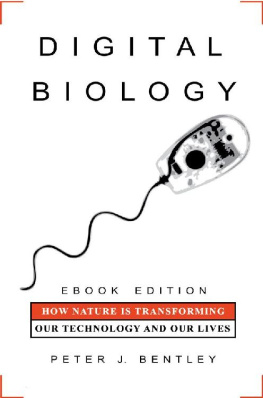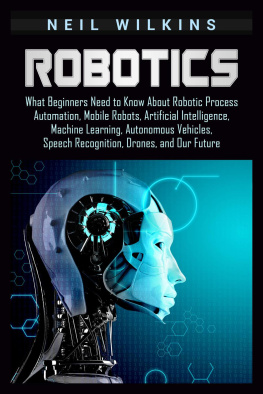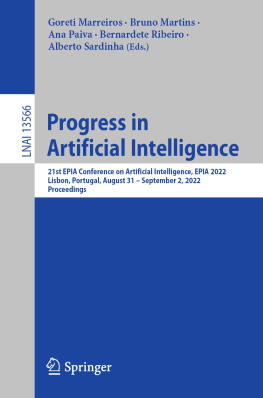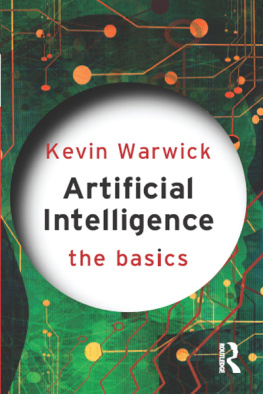Peter J. Bentley - Artificial Intelligence and Robotics
Here you can read online Peter J. Bentley - Artificial Intelligence and Robotics full text of the book (entire story) in english for free. Download pdf and epub, get meaning, cover and reviews about this ebook. year: 2020, publisher: Johns Hopkins University Press, genre: Romance novel. Description of the work, (preface) as well as reviews are available. Best literature library LitArk.com created for fans of good reading and offers a wide selection of genres:
Romance novel
Science fiction
Adventure
Detective
Science
History
Home and family
Prose
Art
Politics
Computer
Non-fiction
Religion
Business
Children
Humor
Choose a favorite category and find really read worthwhile books. Enjoy immersion in the world of imagination, feel the emotions of the characters or learn something new for yourself, make an fascinating discovery.

- Book:Artificial Intelligence and Robotics
- Author:
- Publisher:Johns Hopkins University Press
- Genre:
- Year:2020
- Rating:3 / 5
- Favourites:Add to favourites
- Your mark:
- 60
- 1
- 2
- 3
- 4
- 5
Artificial Intelligence and Robotics: summary, description and annotation
We offer to read an annotation, description, summary or preface (depends on what the author of the book "Artificial Intelligence and Robotics" wrote himself). If you haven't found the necessary information about the book — write in the comments, we will try to find it.
Artificial Intelligence and Robotics — read online for free the complete book (whole text) full work
Below is the text of the book, divided by pages. System saving the place of the last page read, allows you to conveniently read the book "Artificial Intelligence and Robotics" online for free, without having to search again every time where you left off. Put a bookmark, and you can go to the page where you finished reading at any time.
Font size:
Interval:
Bookmark:
Artificial Intelligence and Robotics
Ten Short Lessons
Also in thePOCKET EINSTEINseries
Space Travel: Ten Short Lessons
Ten Short Lessons
Peter J. Bentley

First published in Great Britain in 2020
by Michael OMara Books Limited
9 Lion Yard
Tremadoc Road
London SW4 7NQ
Copyright Michael OMara Books 2020
All rights reserved.
Printed in the United States of America on acid-free paper
2 4 6 8 9 7 5 3 1
Johns Hopkins University Press
2715 North Charles Street
Baltimore, MD 21218-4363
www.press.jhu.edu
Library of Congress Control Number: 2020934701
ISBN 978-1-4214-3972-3 (paperback : acid-free paper)
ISBN 978-1-4214-3973-0 (ebook)
Designed and typeset by Ed Pickford
Illustrations by David Woodroffe
Special discounts are available for bulk purchases of this book. For more information, please contact Special Sales at specialsales@press.jhu.edu.
Johns Hopkins University Press uses environmentally friendly book materials, including recycled text paper that is composed of at least 30 percent post-consumer waste, whenever possible.
I grew up in the 1970s when there was no internet, no World Wide Web, and the very first affordable home computers were just emerging. In those days you had to be a serious geek like me to be into computers. Yes, I was that kid shy at school, but prolific at home, building bizarre robots, programming early computers, writing simple computer games. I would lust after the latest computer as another child might desire a Lamborghini. So amazing, but so unaffordable! Artificial intelligence getting my computers to think, to simulate biological behaviour and control my robots was my childhood passion. But to the people around me, it was a passion that seemed as obscure as stamp collecting might today.
And then things changed. Quite dramatically. Today we live in a science-fiction story come true. Computers rule the world. Data floods from everything we do. Robots are building our products in factories. Our homes are computerized and we can talk to these digital home assistants, receiving detailed and coherent replies. Behind the scenes, artificial intelligence is making everything work. My obscure childhood passion is now not only mainstream, its considered one of the most important kinds of technology being created today.
You cannot live in the modern world without interacting with, or being impacted by, AI and robots. Every time you make a purchase, AIs are handling your money, checking for fraud, using your data to understand you better, and recommending new products to you. Every time you drive a car, AIs are helping the car to proceed safely, theyre watching you from road cameras and automatically changing speed limits, theyre detecting your licence plate and monitoring your movements. Every time you post something on social media, AIs may trawl through the text to understand your sentiment on specific topics. As you browse the internet and read news articles or blogs, AIs monitor your activity and try to please you by feeding you more of the content you prefer. Every time you take a photo, AIs adjust the camera settings and ensure the best possible picture is taken and then can identify everyone in the picture for you. Face recognition, speech understanding, automatic bots that answer your questions online or by phone all performed by AIs. Inside your home you have smart TVs, computerized fridges, washing machines, central heating, air-conditioning systems all AI robotic devices. The world economy is managed by AIs, financial trading is performed by AIs, and decisions about whether you should or should not be accepted for financial products are made by AIs. Your future anti-viral and antibacterial drugs are being designed by AI. Your services of water, electricity, gas, mobile phone and internet connections are all adjusted by smart AI algorithms that try to optimize supply while minimizing waste. You interact with a thousand AIs a day and you are blissfully unaware of them all.
In this book Ill explain a little bit about how this has happened, how it works and what it means. This is a pocket guide, so Im going to be brief. I wont bore you with detailed technical descriptions, I will not explain every single AI technique, and I will not tell you about every AI pioneer. That would take a thousand books of this size, with more books needed every day (progress is fast!). Instead Ill take you on a short journey through this strange world of computers, robots and building brains. Ill try to point out some interesting sights along the way, and explain some of the fundamental ideas behind artificial intelligence and robotics. This journey may sometimes be a rollercoaster, for AI has its ups and downs. It has lived a surprisingly long life already, and suffered the pains of disappointment as well as the excitement of success. It is being created to change our world for the better, yet in some cases it is responsible for causing fundamental problems. Buckle up, and enjoy the ride!
Peter J. Bentley
I confidently predict that in the next ten or fifteen years something will emerge from the laboratory that is not dissimilar to the robot of science-fiction fame.
CLAUDE SHANNON (1961)
Classical stone architecture and statues surround you. You walk through the cobbled streets of the pretty Greek island, admiring the view. The hot sun is now low in the sky, leaving a pleasant evening for a stroll around the town. The hustle and bustle of everyday life has faded away as the market stalls of fruits and fish are closed. There is just the sound of your own footsteps echoing from the ornate buildings. An unexpected movement catches your eye from the corner of the street. Yet there is nobody there. You look harder. The stone statue it moved! You nervously walk over for a closer look. Its chest appears to rise and fall as though it breathes. As you watch, its head turns left, then right. You realize that its not the only one. All the statues on the streets around you seem to display some movement. They move their feet as if adjusting position, they move arms as though having some silent stone discussion. Are they slowly coming to life as night falls? Looking closely, you realize they all seem to have hidden mechanisms, cogs and wheels whirring. Youre on an island of stone robots.
This was the Greek island of Rhodes, as you may have found it 2,400 years ago, even before their giant statue, Colossus of Rhodes, was constructed. It was a remarkable island famed for its mechanical inventions, including life-sized automata made from marble. An Ancient Greek poet named Pindar visited Rhodes and wrote about his experience in a poem:
The animated figures stand
Adorning every public street
And seem to breathe in stone, or
move their marble feet.
It may seem inconceivable that before the Roman Empire in 400 BCE there was such ancient robotic technology. But many ancient examples are well documented. Powered by water or weights, there were mechanical lions that roared, metal birds that sang, and even mechanical people who played together in a band. King Solomon, who reigned from 970 to 931 BCE, was said to have had a golden lion that raised a foot to help him to his throne, and a mechanical eagle that placed his crown upon his head. Ancient Chinese texts tell the story of a mechanical man presented to King Mu of Zhou (1023957 BCE) by the artificer Yan Shi. Archytas, founder of mathematical mechanics, philosopher and pal of Plato, who lived from 428 to 347 BCE, made a mechanical dove a flying, steam-powered wooden robot bird. Hero of Alexandria (1070 CE) wrote an entire book about his automaton inventions, and how hydraulics, pneumatics and mechanics could be used. Hero even created a programmable puppet show that used carefully measured lengths of thread that were pulled by a weight to trigger different events in his choreographed mechanical play.
Next pageFont size:
Interval:
Bookmark:
Similar books «Artificial Intelligence and Robotics»
Look at similar books to Artificial Intelligence and Robotics. We have selected literature similar in name and meaning in the hope of providing readers with more options to find new, interesting, not yet read works.
Discussion, reviews of the book Artificial Intelligence and Robotics and just readers' own opinions. Leave your comments, write what you think about the work, its meaning or the main characters. Specify what exactly you liked and what you didn't like, and why you think so.






